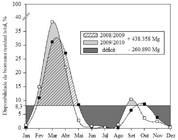ABSTRACT
This study aimed to evaluate the seasonal and spatial availability of harvesting residual biomass of the main grain crops in the region of Campos Gerais - PR, estimate the theoretical potential to electricity production from these residues, as well as identify cities in the region with greater potential for installation of biomass-fueled thermoelectric . Yield data of corn, soybean, wheat, barley, oat and black oat were obtained from the Secretary of Agriculture of Paraná, for the seasons 2008/2009 and 2009/2010, and through the index and harvest calendar, the production and seasonality of total residual biomass of these crops were estimated. Biomass samples were collected from these species and their higher heating value (HHV) and theoretical potential to electricity production were determined. Campos Gerais produced 3.862.130 (2008/2009) and 4.107.932 Mg ha-1 (2009/2010) of total residual biomass with the six crops evaluated. The availability of biomass was concentrated in March and April (about 60%), being negligible in December, January and between June and August. The residual biomass of harvesting grain showed an HHV comparable to forest species, with a total potential energy production of 3.932 (2008/2009) and 4.185 GWh year(1 (2009/2010). Among the cities, Tibagi and Castro are the most promising for the installation of a biomass-fueled thermoelectric , due to their larger production and better seasonal distribution of residuals.
Key words:
straw; bioenergy; agricultural waste.

 Thumbnail
Thumbnail
 Thumbnail
Thumbnail





